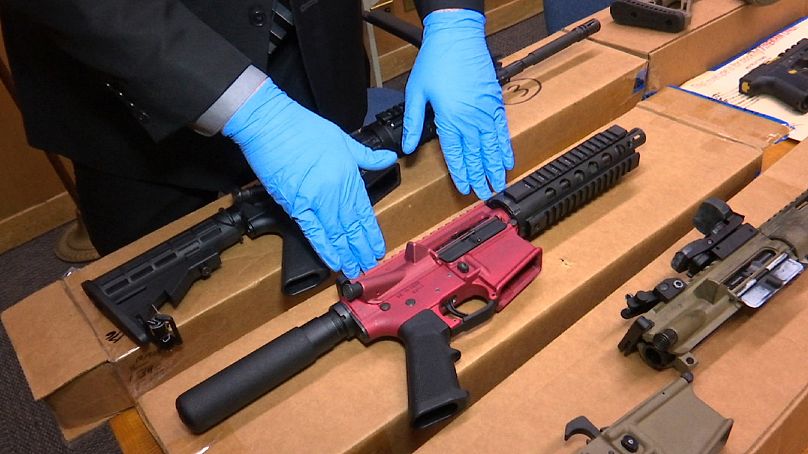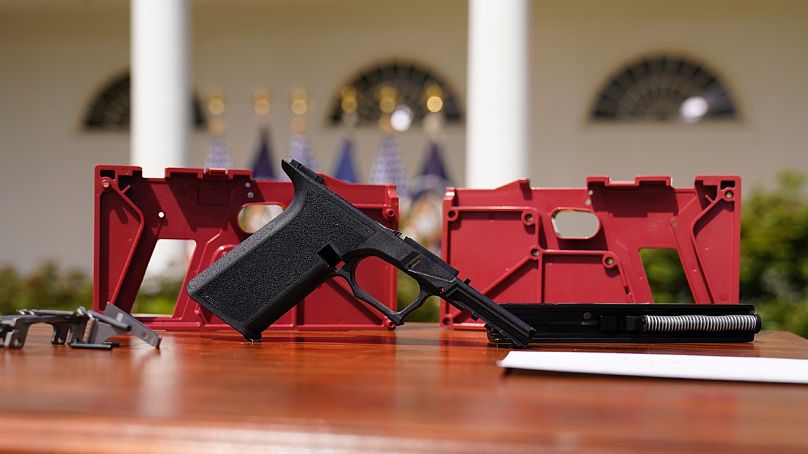Experts say virtually anyone can now make a firearm, with materials and instructions readily available online. Can these DIY "ghost guns" be stopped?
The killing of former Japanese prime minister Shinzo Abe using a handmade gun has revived attention around firearms that can be assembled at home from individual parts, kits, or using 3D printers.
Video images showed the assailant fired at Abe on Friday with a device that had a pistol grip and what appeared to be two pipes covered in black electrical tape. Police arrested a 41-year-old man at the scene and said he had admitted to shooting Abe.
The gun measured 40 cm by 20 cm, and was made of materials such as metal and wood, local officials told reporters. Analysts say the suspect could have made the weapon in a day or two after obtaining readily available materials such as wood and metal pipes.
"The making of guns with a 3D printer and the manufacturing of bombs can nowadays be learned off the internet from anywhere in the world," said Mitsuru Fukuda, a Nihon University professor specialised in crisis management and terrorism who analysed images of the weapon used in Abe's shooting.
There have been several cases in recent years of people being arrested for illegally making firearms – typically with the help of 3D printers – not only in Japan but in other developed countries.
Untraceable homemade firearms are increasingly cropping up in deadly shootings across the United States, and the Biden administration pledged earlier this year to crack down on such unlicensed “ghost guns”.
In Europe, where gun control laws are much stricter than in the United States, the threat posed by unlicensed firearms is also a concern. Counter-terrorism experts say more should be done to curb their spread, and recent violent incidents suggest these weapons are of particular appeal to far-right extremists.
Halle shooting a wake-up call
On October 9, 2019, in the German city of Halle, a young Neo-Nazi wielding homemade firearms tried to storm a synagogue during the Jewish holiday of Yom Kippur. He failed to get in, but killed two bystanders and wounded two more.
The assailant live-streamed the attack, in what he described in a manifesto as a mission to fight “anti-White” people and test how the weapons he had assembled would work. Some of the guns he had were a mix of steel, aluminium, wood and 3D-printed components.
The attack forced Europe to a shocking reckoning over the threat of terrorism using homemade 3D-printed weapons.
Across most of the continent, people need a permit and a psychological evaluation before they’re allowed to possess a gun, and that is only if they can provide a reasonable justification as to why they need one.
But 3D printing has changed everything. Gun enthusiasts now only need access to the internet and less than €100 to build a plastic firearm that’s illegal, yet untraceable and able to pass unnoticed through a metal detector.
Old phenomenon, new tech
Homemade weapons have long been the last resort of insurgents, such as Polish resistants during World War II or Chechen rebels during the second Chechen war against Russia.
But 3D printing has given this old practice a modern twist.
“Creating 3D-printed weapons is a fairly new phenomenon. And that really has to do with the fact that 3D printed technology has become democratised in the last 15 years or so,” said Yannick Veilleux-Lepage, an assistant professor focusing on terrorism and political violence at Leiden University in the Netherlands.
“It’s an old technology. It's existed since the 1980s, but before it was really used in very distinctive environments, like in manufacturing to do things like rapid prototyping,” he told Euronews Next.
Back then, 3D printing was only available to people working in specific industries or to researchers in universities. But between the early 2000s and 2010s, the cost of 3D technology went down and production was scaled up, leading to an explosion of 3D printing at home.
Most of it came without harmful intentions.
“But like most technologies, it has a dark side to it, and there is this subset of the 3D printing community that has become somewhat fixated on printing weapons,” said Veilleux-Lepage, who is also an associate fellow of the International Centre for Counter-Terrorism (ICCT).
Now, with the help of blueprints easily available online, pretty much anyone can build their own gun at home.
Veilleux-Lepage estimates it would take only 20 to 30 hours of trial and error to make a Liberator, the world’s first model of a 3D-printable handgun, whose blueprint was released by a young American gun rights activist in 2013.
Other designs for more elaborate weapons, which may require external, non-3D-printed components, might however require more money and energy, he said.
Far-right obsession
Stephan Balliet, the Halle synagogue shooter, was a neo-Nazi.
Since his attack, the UK has arrested four people for making and possessing 3D-printed guns, while Spanish police have dismantled an illegal workshop in Tenerife that was using 3D printers to produce guns. Both cases were found to also be linked to far-right movements.
In the Spanish workshop where they seized 3D-printed weapons - including a replica assault rifle and several gun barrels - police found manuals on urban guerrilla warfare and white supremacist literature.
According to Veilleux-Lepage, this style of DIY weapons appeals to far-right movements who seek to act outside of the control of the governing elites and are fascinated with survivalism.
“There's certain places where this kind of aspect of creating your own weapon and being able to do so completely outside of the purview of government and this notion of self-sufficiency will also transpose quite well on to far-right ideology,” he said.
“Groups which are skeptical of government overreach, or skeptical of gun control, who are skeptical of having the means of production within the hands of a few elites".
What is Europe doing to fight 3D-printed guns?
The 3D printing of firearms by private individuals is illegal across Europe.
In theory, weapons can only be 3D-printed and manufactured by licensed dealers, and are subject to restrictions such as authorisation before private acquisition.
In reality, the threat posed by untraceable ghost guns is very much on the radar of European authorities, which are considering further steps to contain it.
In 2018, before the deadly attack in Halle, EUROPOL had warned that technological progress would make 3D printing available to more people, and that this could boost the illicit production and trade of firearms across the continent.
In an October 2021 report to the EU Parliament and Council, the European Commission identified the most dangerous threat as the manufacturing of “so-called hybrid 3D-printing weapons, which rely on both 3D-printed parts and readily available components that are globally unregulated, such as steel tubing, metal bar stock, and springs”.
In that report, the Commission said it was assessing whether to make the ownership and sharing of blueprints for 3D-printed weapons illegal too.
The UK is also carefully following the situation.
“Criminals who use any type of firearm have clear intentions; to spread fear, incite violence and cause harm to our communities,” said Matt Perfect, head of the UK’s National Firearms Targeting Centre.
“The manufacture or possession of 3D printed weapons is covered under existing firearms legislation. We are closely monitoring the impact of 3D guns and their unique vulnerabilities, working closely with partners to suppress the availability of illegal firearms in the UK”.
Can 3D-printed 'ghost guns' be stopped?
Veilleux-Lepage expects to see an increase in the manufacturing and use of 3D-printed weapons in Europe and in the US, “just because that technology is existing and is being democratised and is easier to access now than it was 10 years ago”.
But he seriously doubts that 3D-printed guns could become the preferred weapon for terror attacks in Europe.
“If you look at the majority of terrorist incidents in the Western world that have used firearms, craft weapons are not generally preferred,” Veilleux-Lepage said.
“Particularly when you're looking at jihadists, what they have done is use decommissioned weapons like prop-guns - which are real firearms - which were deactivated and they have sought to reactivate,” he added.
As much as 3D-printing a weapon allows people to easily bypass permitting and licensing, it’s certainly not the most immediate method of obtaining a gun, especially as not everyone might be familiar with 3D printing.
“There are more reliable ways to obtain firearms,” said Veilleux-Lepage.
He also believes some practical solutions could help fight the spread of 3D-printed weapons.
Social media giants Instagram, Facebook and TikTok could for instance agree that sharing information on how to build 3D-printed weapons violates their terms of service, he said.
Technology like the one applied on banknotes, which nullifies attempts at photocopying money, could also be implemented on the blueprints of 3D-printed weapons.
“Now that doesn't mean that nobody is going to be able to overcome this. Some people will be,” Veilleux-Lepage cautioned.
“But it's about upping the bar, making it harder, making it so that, you know, the angry 15-year-old who is being bullied in school can't go and print a 3D-printed gun in his bedroom because he's angry”.













